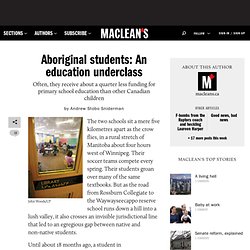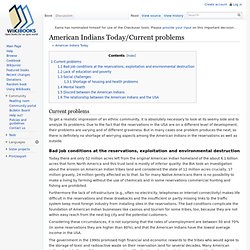

Aboriginal students: An education underclass - Canada. John Woods/CP The two schools sit a mere five kilometres apart as the crow flies, in a rural stretch of Manitoba about four hours west of Winnipeg.

Their soccer teams compete every spring. Their students groan over many of the same textbooks. But as the road from Rossburn Collegiate to the Waywayseecappo reserve school runs down a hill into a lush valley, it also crosses an invisible jurisdictional line that led to an egregious gap between native and non-native students. Until about 18 months ago, a student in Waywayseecappo received about $7,300 in annual funding from the federal government, while a student at Rossburn Collegiate received about $10,500 from the provincial government.
Shared Stories of Residential School Survivors. The young girl, whose mother had died in childbirth, was being cared for by her aunt and uncle.

“But I came into the wrong hands when I was six,” Flanders told attendees at the Truth and Reconciliation Commission this week. As TRC commissioners Marie Wilson and Chief Wilton Littlechild listened, Flanders described the sense of sheer isolation and loneliness that she felt as a boarding student at St. Michael’s Indian Residential School in Alert Bay. For 10 years, she missed out on typical childhood experiences, like knowing what it was like to celebrate a birthday, or going home to see her family for Christmas.
Equal Education for First Nations. American Indians Today/Current problems. Current problems To get a realistic impression of an ethnic community, it is absolutely necessary to look at its seemy side and to analyze its problems.

Due to the fact that the reservations in the USA are on a different level of development, their problems are varying and of different graveness. But in many cases one problem produces the next, so there is definitely no shortage of worrying aspects among the American Indians in the reservations as well as outside. Bad job conditions at the reservations, exploitation and environmental destruction Today there are only 52 million acres left from the original American Indian homeland of the about 6.1 billion acres that form North America and this trust land is mostly of inferior quality: the BIA took an investigation about the erosion on American Indian tribes land and considered the state of 12 million acres crucially, 17 million gravely, 24 million gently affected as to that.
Lack of education and poverty Social challenges Mental health. The Residential School System. Children's dining room, Indian Residential School, Edmonton, Alberta.

Between 1925-1936. United Church Archives, Toronto, From Mission to Partnership Collection. Residential Schools. The change in aboriginal people. The Legacy of Indian Residential Schools. Last week, Indian and Northern Affairs Minister Jim Prentice stated a final compensation package for Indian residential school survivors was only days away.

But rather than rushing through a deal brokered by the previous government, Prentice should re-consider the "common experience payments". Last year the previous federal government announced they signed an agreement with the Assembly of First Nations to negotiate a $1.9-billion lump sum payout to all - approximately 86,000 - living former students of Indian residential schools. The "common experience payment" of $10,000 would be paid all former students. By signing the agreement, the federal government signals that all residential schools were bad and no student ever benefited from attending them. Female Education. Intergration of Christianism.